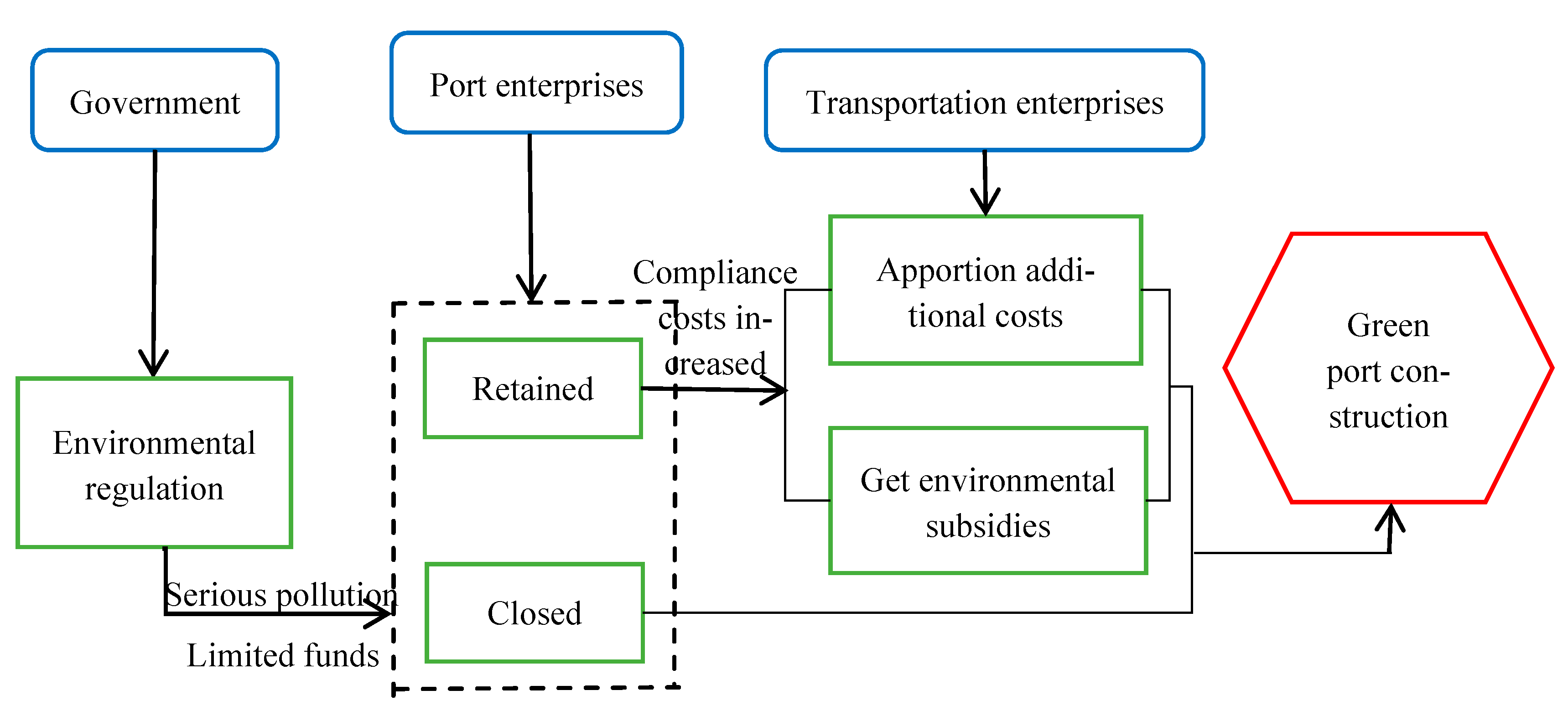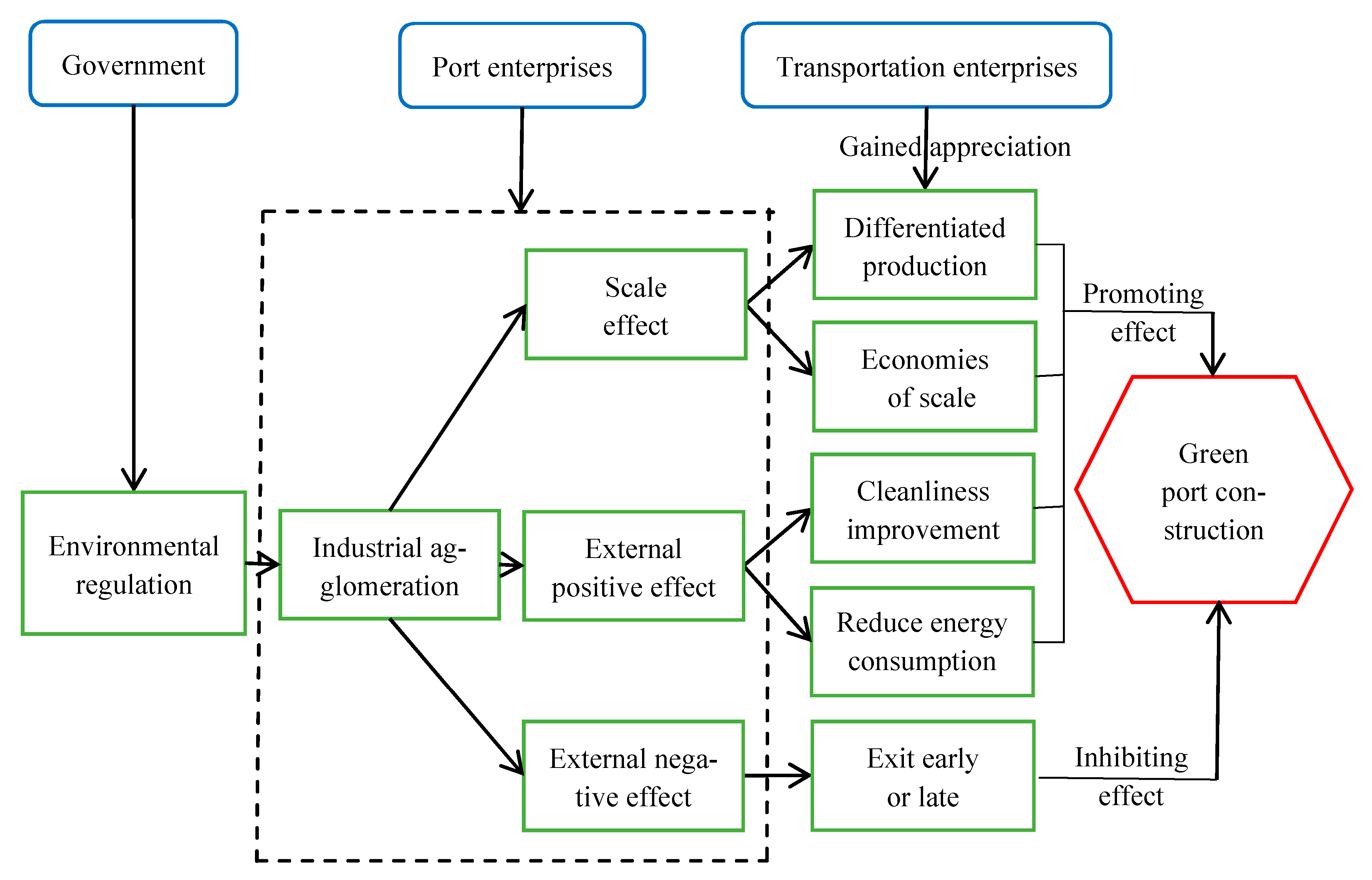Influence Mechanism and Evolutionary Game of Environmental Regulation on Green Port Construction
Abstract
:1. Introduction
2. Literature Review
3. Influence Mechanism of Environmental Regulation on Green Port Construction
3.1. Direct Influence Mechanism of Environmental Regulation on Green Port Construction
3.2. Indirect Influence Mechanism of Environmental Regulation on Green Port Construction
- (1)
- Intermediary role of green innovation
- (2)
- Intermediary role of industrial agglomeration
- (3)
- Intermediary role of green logistics “forced”
4. Evolutionary Game of Green Port Construction under Environmental Regulation
4.1. Basic Assumptions and Model Construction
4.2. Evolutionary Stability Analysis of the Game Model
- (1)
- Evolutionary stability analysis of government
- i.
- When , . At this point, no matter the value of x, the government’s strategy choice remains in a stable state.
- ii.
- When , , . At this point, is the evolutionary equilibrium point, and the government will tend to reg-ulate the environment.
- iii.
- When , , . At this point, is the evolutionary equilibrium point, and the government will tend not to regulate the environment.
- (2)
- Evolutionary stability analysis of port enterprises
- i.
- When , . At this point, no matter the value of y, port enterprises’ strategic choice remains in a stable state.
- ii.
- When , , . At this point, is the evolutionary equilibrium point, and port enterprises will be inclined to construct green ports.
- iii.
- When , , . At this point, is the evolutionary equilibrium point, and port enterprises will tend not to build green ports.
- (3)
- Evolutionary stability analysis of transport enterprises
- i.
- When , . At this point, no matter the value of z, the transportation enterprise’s strategy choice is in a stable state.
- ii.
- When , to take , let z = 0 or z = 1. At this point, the transportation enterprise’s strategy choice is in a stable state.
- a
- When , , . At this point, it is a stable strategy for transportation enterprises to adopt the green port transportation mode. On the contrary, it is an unstable strategy.
- b
- When :
4.3. Asymptotic Stability Analysis of Game Model
- (1)
- Analysis of equilibrium point (0, 0, 0)
- (2)
- Analysis of other equilibrium points
- (3)
- Analysis of equilibrium point (0, 1, 1)
- (4)
- Analysis of equilibrium point (1, 1, 1)
- i.
- When the regulatory cost of environmental regulation by the government is lower than the sum of the reputation cost caused by criticism and the green port construction cost transferred by port enterprises, the government will choose environmental regulation.
- ii.
- When the difference between the revenue obtained by the port enterprises when they do not construct the green port and the sum of pollution compensation to the transportation enterprise and the fines is lower than the difference between the sum of their own revenues and extra income and the cost of green port construction, port enterprises will choose green port construction.
5. Conclusions and Suggestions
5.1. Conclusions
5.2. Suggestions
Author Contributions
Funding
Institutional Review Board Statement
Informed Consent Statement
Data Availability Statement
Acknowledgments
Conflicts of Interest
References
- Chu, B. Accelerate the construction of world-class ports and better serve the major national strategies. China Water Transport News, 18 December 2019. [Google Scholar]
- Lu, B.; Wang, H.P. The countermeasures of government promoting green port construction based on evolutionary game. East China Econ. Manag. 2017, 31, 153–159. [Google Scholar]
- Zhen, L.; Zhuge, D.; Wang, X.F. Review on green port and shipping management. Syst. Eng.-Theory Pract. 2020, 40, 2037–2050. [Google Scholar]
- Venturini, G.; Iris, Ç.; Kontovas, C.A.; Larsen, A. The multi-port berth allocation problem with speed optimization and emission considerations. Transp. Res. Part D Transp. Environ. 2017, 5, 142–159. [Google Scholar] [CrossRef] [Green Version]
- Dulebenets, M.A.; Moses, R.; Ozguven, E.E.; Vanli, A. The minimizing carbon dioxide emissions due to container handling at marine container terminals via hybrid evolutionary algorithms. IEEE Access 2017, 5, 8131–8147. [Google Scholar] [CrossRef]
- Peng, Y.; Liu, H.; Li, X.; Huang, J.; Wang, W. Machine learning method for energy consumption prediction of ships in port considering green ports. J. Clean. Prod. 2020, 264, 121564. [Google Scholar] [CrossRef]
- Kang, D.; Kim, S. Conceptual model development of sustainability practices: The case of port operations for collaboration and governance. Sustainability 2017, 9, 2333. [Google Scholar] [CrossRef] [Green Version]
- Kim, S.; Chiang, B.G. The role of sustainability practices in international port operations:An analysis of moderation effect. J. Korea Trade 2017, 21, 125–144. [Google Scholar] [CrossRef]
- Lam, J.S.L.; Notteboom, T. The greening of ports: A comparison of port management tools used by leading ports in Asia and Europe. Transp. Rev. 2014, 34, 169–189. [Google Scholar] [CrossRef]
- Antão, P.; Calderón, M.; Puig, M.; Michail, A.; Wooldridge, C.; Darbra, R.M. Identification of occupational health, safety, security(OHSS) and environment performance indicators in port areas. Saf. Sci. 2016, 85, 266–275. [Google Scholar] [CrossRef] [Green Version]
- Wan, C.; Zhang, D.; Yan, X.; Yang, Z. A novel model for the quantitative evaluation of green port development:A case study of major ports in China. Transp. Res. Part D Transp. Environ. 2018, 61, 431–443. [Google Scholar] [CrossRef]
- Wang, L.; Zhou, Z.; Yang, Y.; Wu, J. Green efficiency evaluation and improvement of Chinese ports: A cross-efficiency model. Transp. Res. Part D Transp. Environ. 2020, 88, 102590. [Google Scholar] [CrossRef]
- Shao, C.F.; Ju, M.T.; Chu, C.L. Construction ideas and development countermeasures of ecological port in China. J. Ecol. 2008, 28, 5601–5609. [Google Scholar]
- Xu, Y.; Meng, Y.P. Evolutionary Game between government and port enterprises under compulsory emission reduction. J. Univ. Sci. Technol. China 2019, 49, 762–772. [Google Scholar]
- Acciaro, M.; Vanelslander, T.; Sys, C.; Ferrari, C.; Roumboutsos, A.; Giuliano, G.; Lam, J.S.; Kapros, S. Environmental sustainability in seaports: A framework for successful innovation. Marit. Policy Manag. 2014, 41, 480–500. [Google Scholar] [CrossRef]
- Elen, T.; Marina, Z. Improvement of the sustainability of ports logistics by the development of innovative green infrastructure solutions. Transp. Res. Procedia 2020, 45, 539–546. [Google Scholar]
- Li, Y.; Hu, Z.Y.; He, B.Y. Analysis on the mechanism and effect of environmental regulation on green economic development. China Soft Sci. 2020, 9, 26–38. [Google Scholar]
- Kang, P.H.; Ru, S.F. Decomposition of bilateral effect of green innovation in environmental regulation. China Popul. Resour. Environ. 2020, 30, 93–104. [Google Scholar]
- Fan, D.; Sun, X.T. Environmental regulation, green technological innovation and green economic growth. China Popul. Resour. Environ. 2020, 30, 105–115. [Google Scholar]
- Lei, Y.T.; Zhang, S.W.; Sun, J.J. The influence mechanism and empirical study of environmental regulation on green transformation of manufacturing industry. Sci. Technol. Prog. Policy 2020, 37, 63–70. [Google Scholar]
- Wang, L.M.; Zhao, Y.L.; Wang, S. Research on the impact of China’s high-tech industrial agglomeration model on the efficiency of green innovation. Manag. Mod. 2022, 1, 17–23. [Google Scholar]
- Li, H.; Chen, L.Z. The Influence of green Logistics development level on China’s export Trade: A case study of Portuguese-speaking countries. Asia-Pac. Econ. Rev. 2017, 5, 78–83+175. [Google Scholar]
- Donaldson, T.; Preston, L.E. The stakeholder theory of the corporation: Concepts, evidence, and implication. Acad. Manag. Rev. 1995, 20, 65–91. [Google Scholar] [CrossRef]
- Li, W.H.; Li, N.; Liu, F. Three parties’evolutionary game of stakeholders in green technology innovation and their simulation. Oper. Res. Manag. 2021, 30, 216–224. [Google Scholar]
- Weibull, J.W. Evolutionary Game Theory; Shanghai People’s Publishing House: Shanghai, China, 2006. [Google Scholar]
- Fan, H.W.; Chang, Z.; Fu, K. Research on subsidy game of port enterprises’ green technology adoption under carbon quota constraint. J. Dalian Marit. Univ. 2021, 1–10. Available online: https://kns.cnki.net/kcms/detail/21.1360.U.20211108.1348.002.html (accessed on 8 November 2021).
- Wang, P.; Liu, S.Q. Evolutionary game study of green technology innovation under market oriented mechanism considering the additional utility of consumers to green products. Econ. Probl. 2022, 1, 67–77. [Google Scholar]
- Xu, F.W.; Ding, Y.D.; Zhang, Z.F. Evolutionary game analysis of green supply chain considering consumers’ green preference under government regulation. Environ. Sci. Manag. 2021, 46, 5–10. [Google Scholar]
- Lu, C.; Cheng, H.F.; Cai, J.H. Evolutionary game analysis: Impacts of government subsidies on manufacturers’ green R&D under peer incentive mechanism. Chin. J. Manag. 2022, 19, 93–101. [Google Scholar]
- He, Z.; Qu, J.J.; Li, B. Evolutionary game analysis of cooperative innovation behaviors of green supply chain enterprises considering government rewards and punishments. Ecol. Econ. 2021, 37, 62–70. [Google Scholar]




| Port enterprises construct green port (y) | Port enterprises do not construct green port (1 − y) | |||
| Transportation enterprises adopt green port logistics (z) | Transportation enterprises do not adopt green port logistics (1 − z) | Transportation enterprises adopt green port logistics (z) | Transportation enterprises do not adopt green port logistics (1 − z) | |
| The government regulates environment (x) | P1 − C1 | P1 − C1 | P2 − C1 + C-R1 | P2− C1 + C-R1 |
| P3 + P2 − C2 | P3 − C2 | P4 − C-R2 | P4 − C | |
| W + P1 | W | R1 + R2 | R1 | |
| The government does not regulate environment (1 − x) | P1 − C3 − C5 | P1 − C3 − C5 | P2 − C5 | P2 − C5 |
| P3 + P2 − C2 + C3 + C4 | P3 − C2 + C3 + C4 | P4 − R2 | P4 | |
| W + P1 − C4 | W − C4 | R2 | 0 | |
| Equilibrium Points | Eigenvalues | Asymptotic Stability | ||
|---|---|---|---|---|
| (0, 0, 0) | Saddle point | |||
| (0, 0, 1) | Saddle point or stable point | |||
| (0, 1, 0) | Saddle point or unstable point | |||
| (0, 1, 1) | Saddle point or stable point | |||
| (1, 0, 0) | Saddle point or unstable point | |||
| (1, 0, 1) | Saddle point or stable point | |||
| (1, 1, 0) | Saddle point or unstable point | |||
| (1, 1, 1) | Saddle point or stable point | |||
Publisher’s Note: MDPI stays neutral with regard to jurisdictional claims in published maps and institutional affiliations. |
© 2022 by the authors. Licensee MDPI, Basel, Switzerland. This article is an open access article distributed under the terms and conditions of the Creative Commons Attribution (CC BY) license (https://creativecommons.org/licenses/by/4.0/).
Share and Cite
Deng, G.; Chen, J.; Liu, Q. Influence Mechanism and Evolutionary Game of Environmental Regulation on Green Port Construction. Sustainability 2022, 14, 2930. https://doi.org/10.3390/su14052930
Deng G, Chen J, Liu Q. Influence Mechanism and Evolutionary Game of Environmental Regulation on Green Port Construction. Sustainability. 2022; 14(5):2930. https://doi.org/10.3390/su14052930
Chicago/Turabian StyleDeng, Gaodan, Jingxiao Chen, and Quanlong Liu. 2022. "Influence Mechanism and Evolutionary Game of Environmental Regulation on Green Port Construction" Sustainability 14, no. 5: 2930. https://doi.org/10.3390/su14052930
APA StyleDeng, G., Chen, J., & Liu, Q. (2022). Influence Mechanism and Evolutionary Game of Environmental Regulation on Green Port Construction. Sustainability, 14(5), 2930. https://doi.org/10.3390/su14052930






